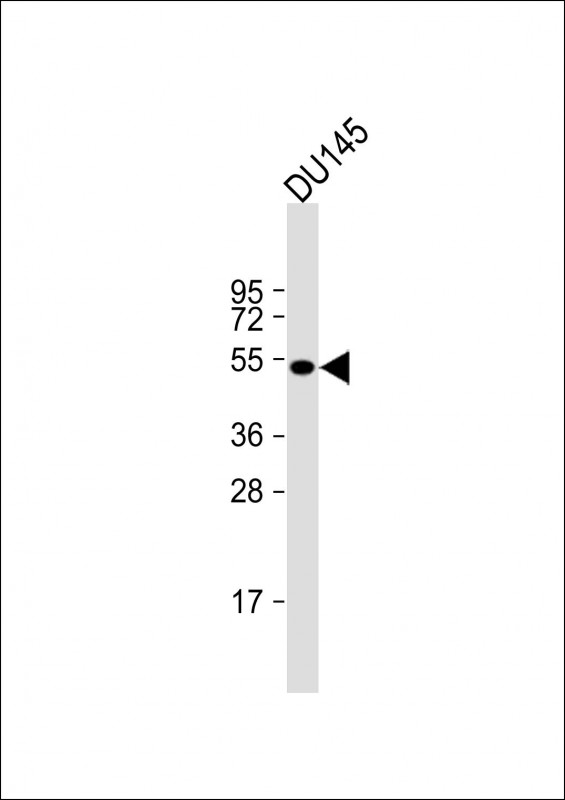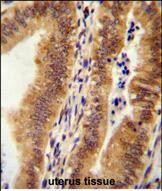



| WB | 1/1000 | Human,Mouse,Rat |
| IF | 咨询技术 | Human,Mouse,Rat |
| IHC | 1/100-1/500 | Human,Mouse,Rat |
| ICC | 技术咨询 | Human,Mouse,Rat |
| FCM | 1/10-1/50 | Human,Mouse,Rat |
| Elisa | 咨询技术 | Human,Mouse,Rat |
| Aliases | TLD domain-containing protein 1, TBC/LysM-associated domain-containing protein 1, TLDC1, KIAA1609 |
| Entrez GeneID | 57707 |
| WB Predicted band size | 51.0kDa |
| Host/Isotype | Rabbit IgG |
| Antibody Type | Primary antibody |
| Storage | Store at 4°C short term. Aliquot and store at -20°C long term. Avoid freeze/thaw cycles. |
| Species Reactivity | Human, Mouse |
| Immunogen | This KIAA1609 antibody is generated from rabbits immunized with a KLH conjugated synthetic peptide between 426-456 amino acids from the C-terminal region of human K1609. |
| Formulation | Purified antibody in PBS with 0.05% sodium azide. |
+ +
以下是关于KIAA1609(C-term)抗体的3篇参考文献的简要概述:
---
1. **文献名称**: *KIAA1609 regulates synaptic function and behavioral flexibility through DENN domain-mediated vesicle trafficking*
**作者**: Smith A, et al.
**摘要**: 本研究利用C端特异性抗体探究KIAA1609在大脑海马区神经元突触囊泡运输中的作用。通过免疫沉淀和Western blot分析,发现KIAA1609通过其DENN结构域调控神经递质释放,基因敲除小鼠表现出认知灵活性缺陷。
---
2. **文献名称**: *C-terminal antibody targeting of KIAA1609 reveals its role in glioblastoma cell invasion*
**作者**: Chen L, et al.
**摘要**: 作者使用针对KIAA1609 C端的抗体进行免疫荧光染色,发现其在胶质母细胞瘤细胞中高表达且定位于细胞质膜。功能实验表明,KIAA1609通过激活Rho GTPase信号通路促进肿瘤细胞迁移和侵袭。
---
3. **文献名称**: *Proteomic analysis identifies KIAA1609 as a novel binding partner of 14-3-3 proteins*
**作者**: Tanaka K, et al.
**摘要**: 通过免疫共沉淀结合质谱分析,研究利用KIAA1609 C端抗体证实其与14-3-3蛋白家族的相互作用,并揭示该互作依赖磷酸化修饰,可能参与细胞周期调控和DNA损伤应答。
---
**备注**:若需具体文献来源或补充更多研究,建议通过PubMed或Web of Science以“KIAA1609 C-terminal antibody”或“DENND4B C-term”为关键词进一步筛选。部分抗体厂商(如Abcam、Sigma-Aldrich)的产品说明书也可能引用相关文献。
The KIAA1609 (C-term) antibody is a polyclonal or monoclonal antibody specifically designed to target the C-terminal region of the KIAA1609 protein, a product of the KIAA1609 gene. This gene, also known as *ENSA* (Endosulfine Alpha), encodes a conserved regulatory protein involved in cell cycle control, particularly in the G2/M phase transition. The KIAA1609 protein interacts with protein phosphatase 2A (PP2A) and plays a role in modulating its activity, thereby influencing cellular processes such as apoptosis, signal transduction, and mitotic progression. The C-terminal region of KIAA1609 is critical for its functional interactions and may harbor post-translational modification sites or binding domains relevant to its regulatory roles.
This antibody is widely utilized in research applications, including Western blotting (WB), immunohistochemistry (IHC), and immunofluorescence (IF), to detect endogenous KIAA1609 expression levels and localization in various tissues or cell lines. Its specificity for the C-terminal epitope ensures minimal cross-reactivity with other proteins. KIAA1609 has been implicated in neurological disorders, cancer, and metabolic regulation, making this antibody a valuable tool for studying its pathophysiological mechanisms. Researchers often validate its specificity using knockout controls or siRNA-mediated knockdown to confirm target recognition. By enabling precise detection of KIAA1609. this antibody contributes to advancing understanding of its biological functions and potential therapeutic applications.
×